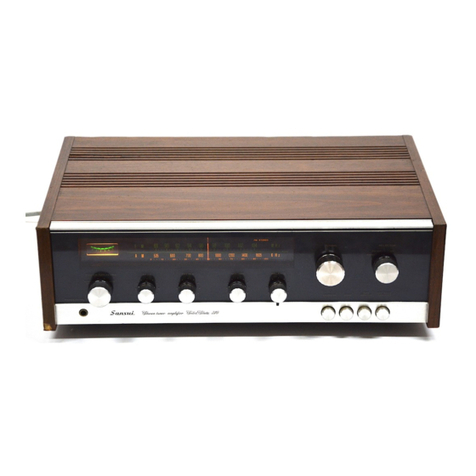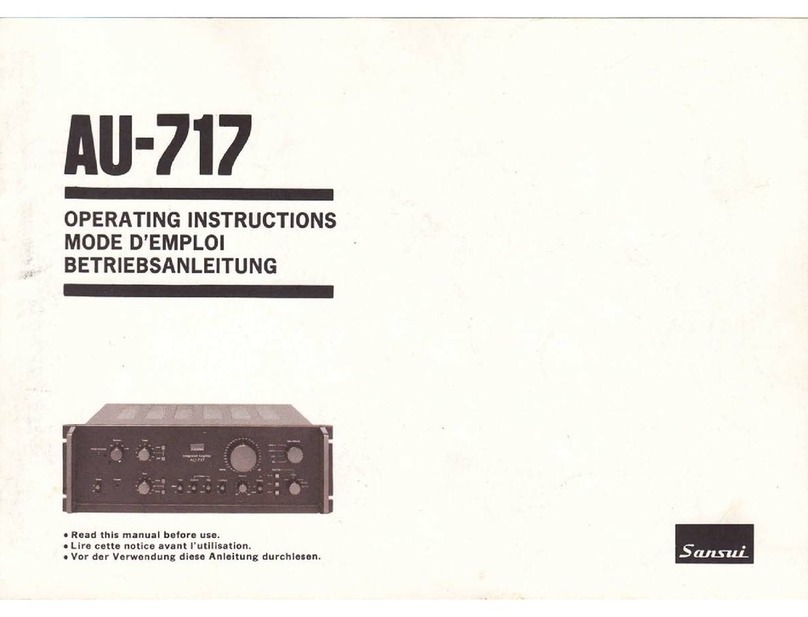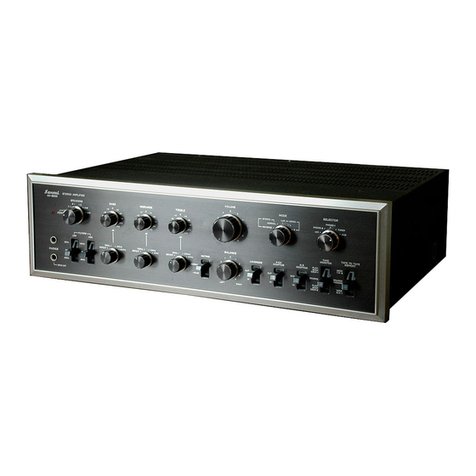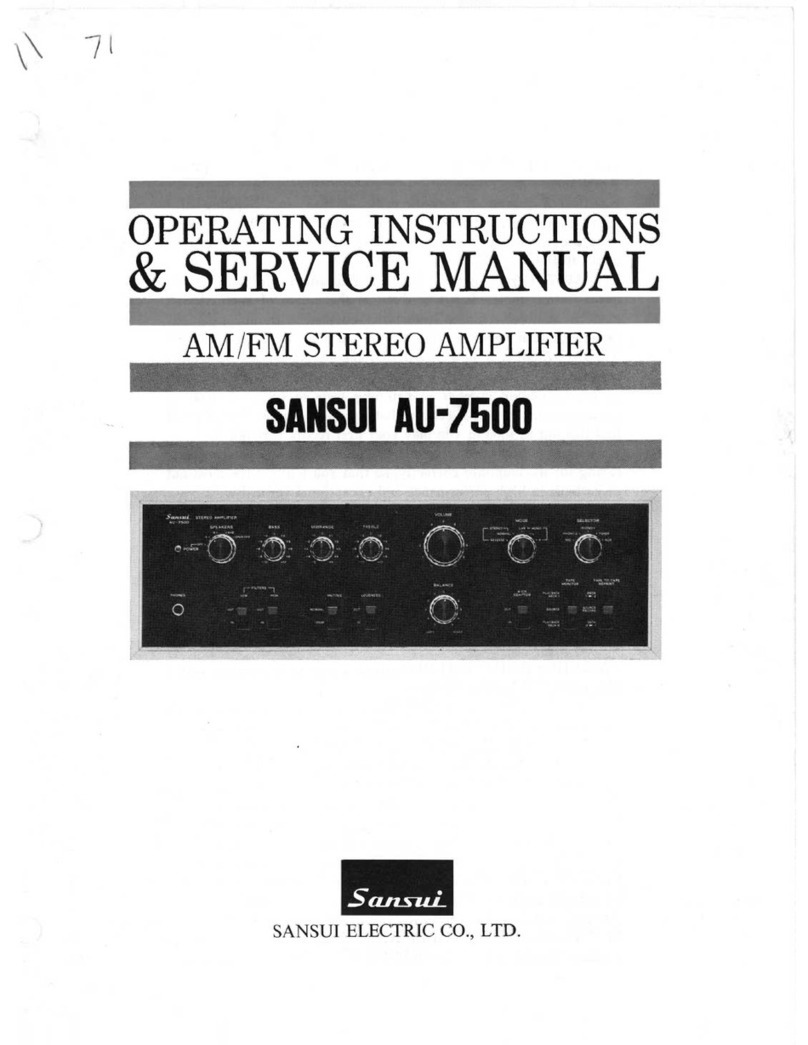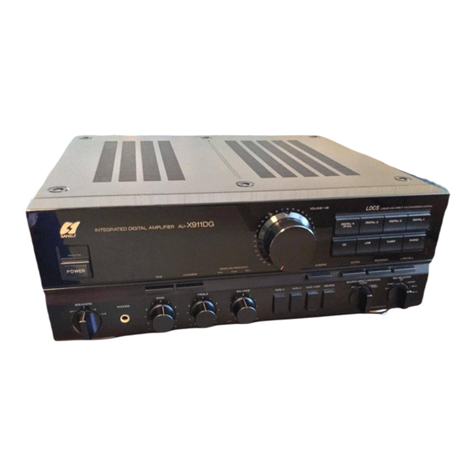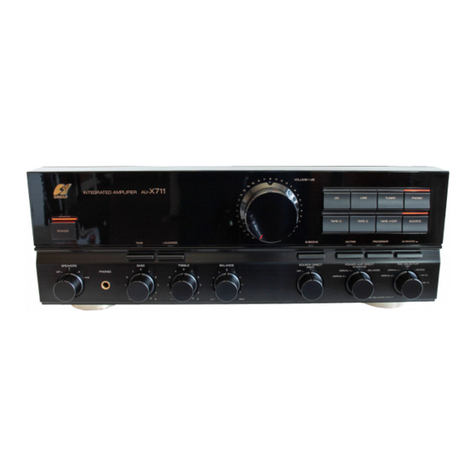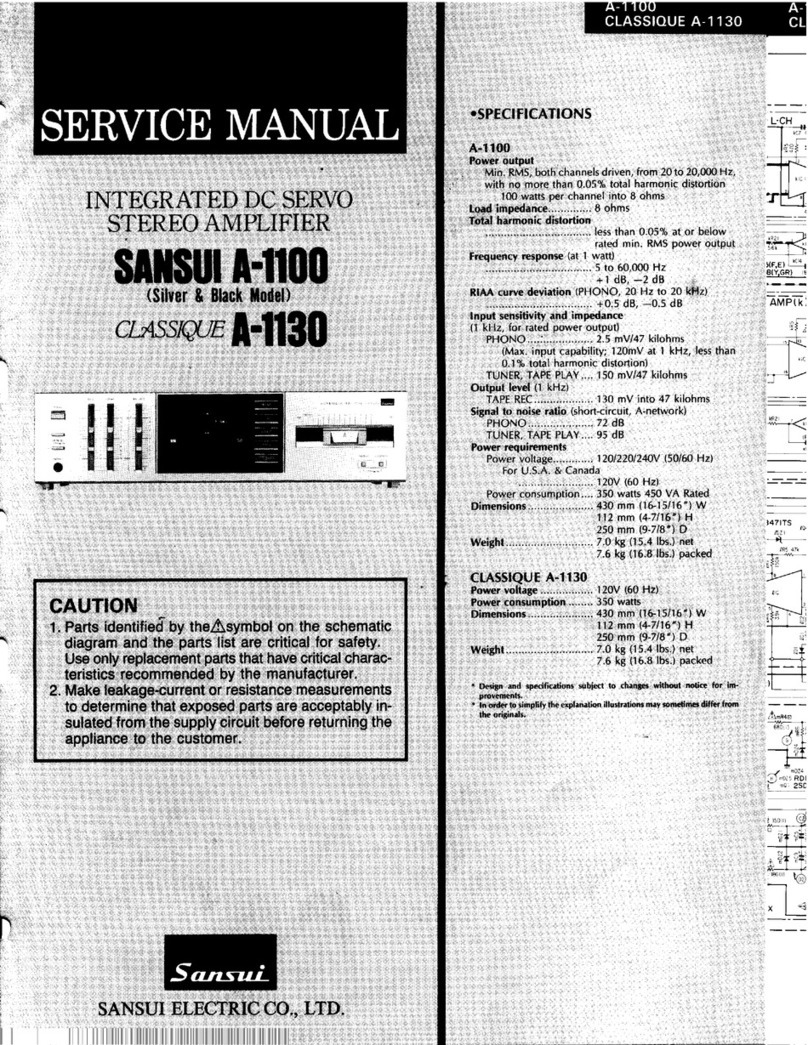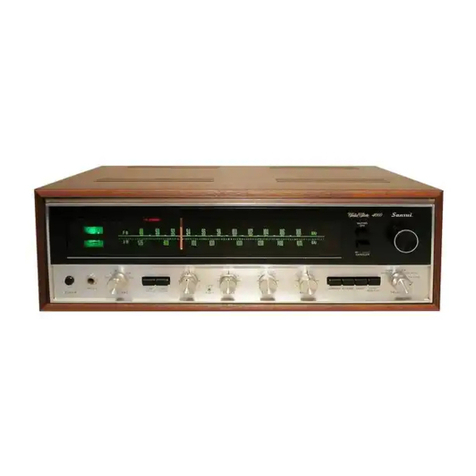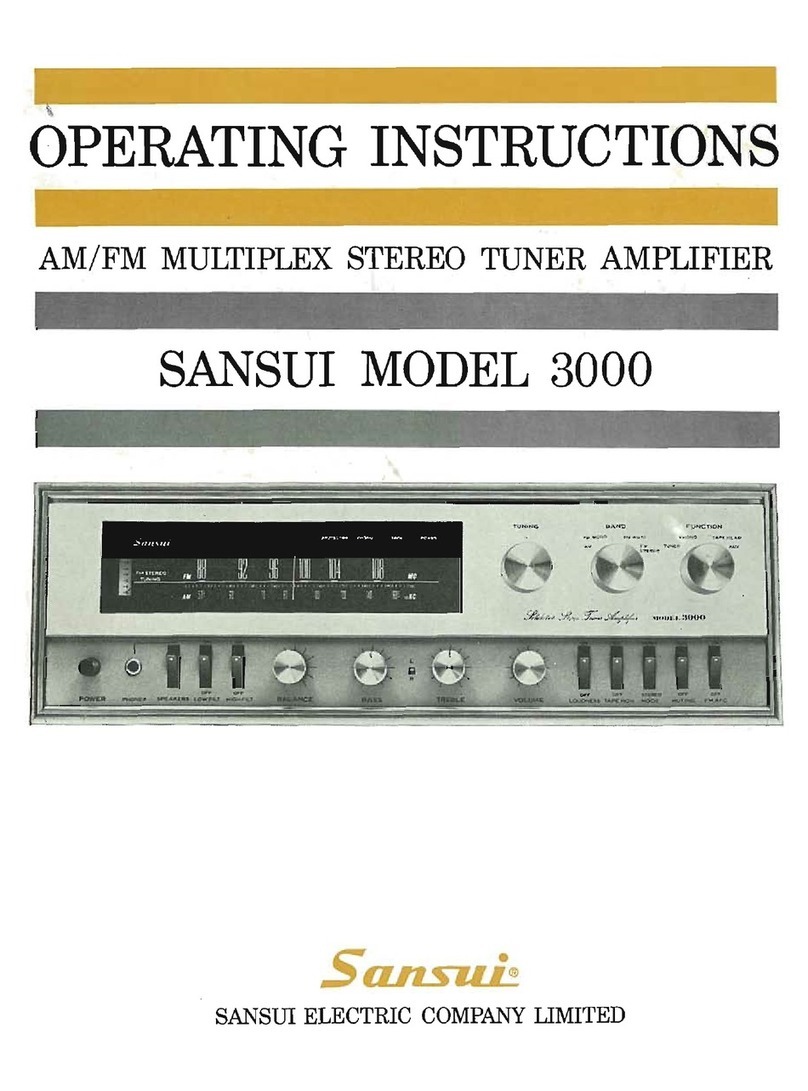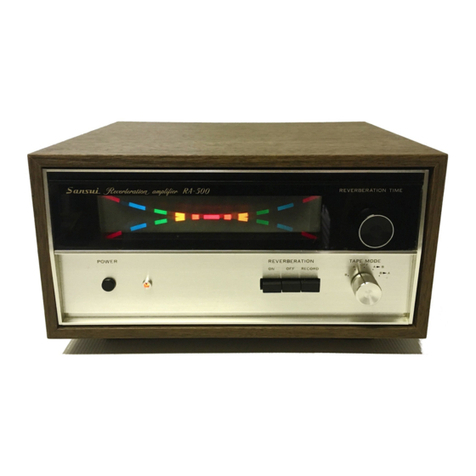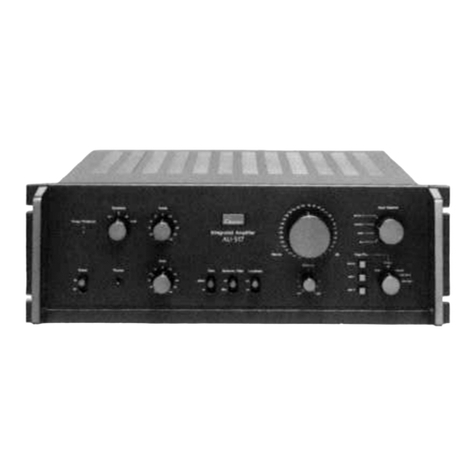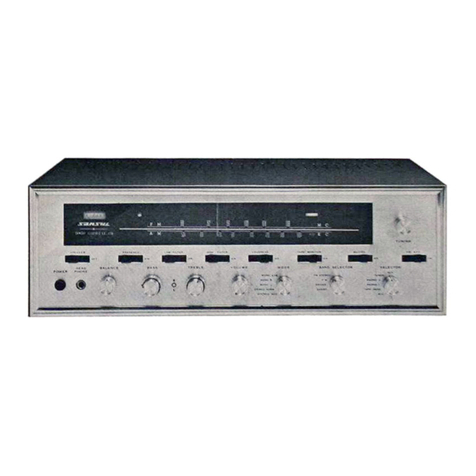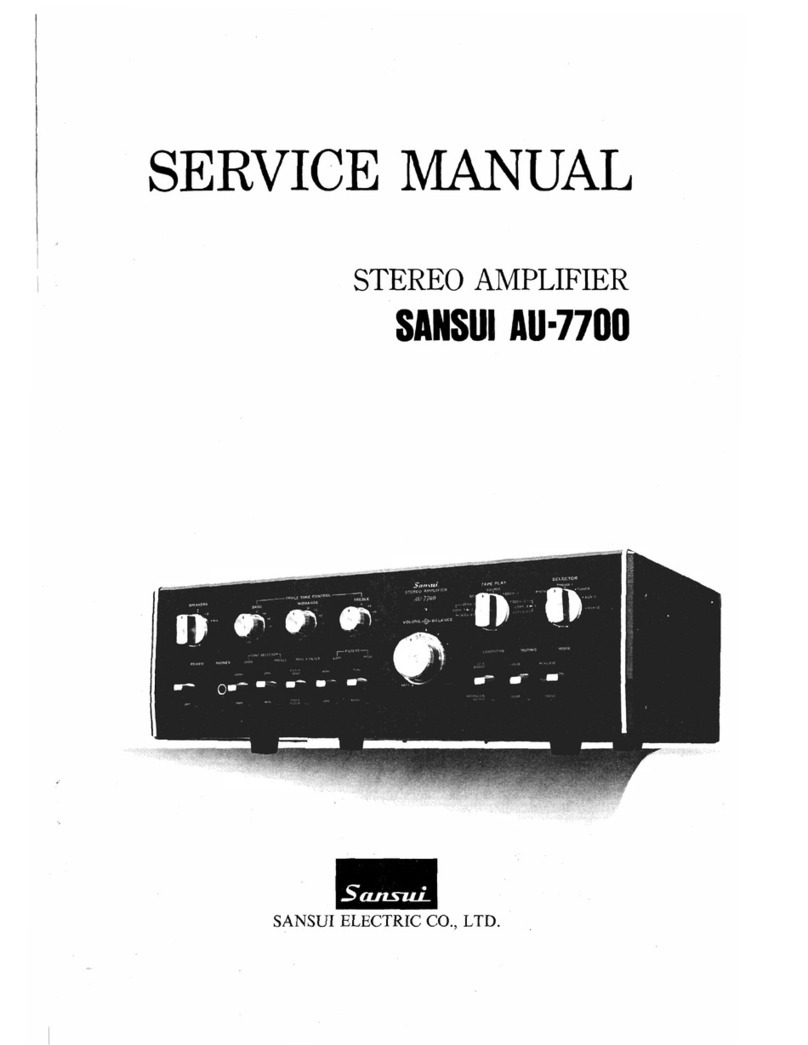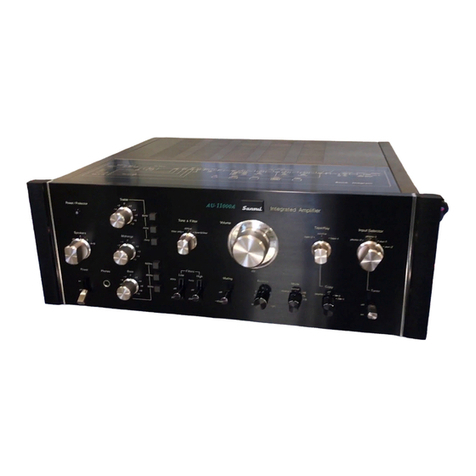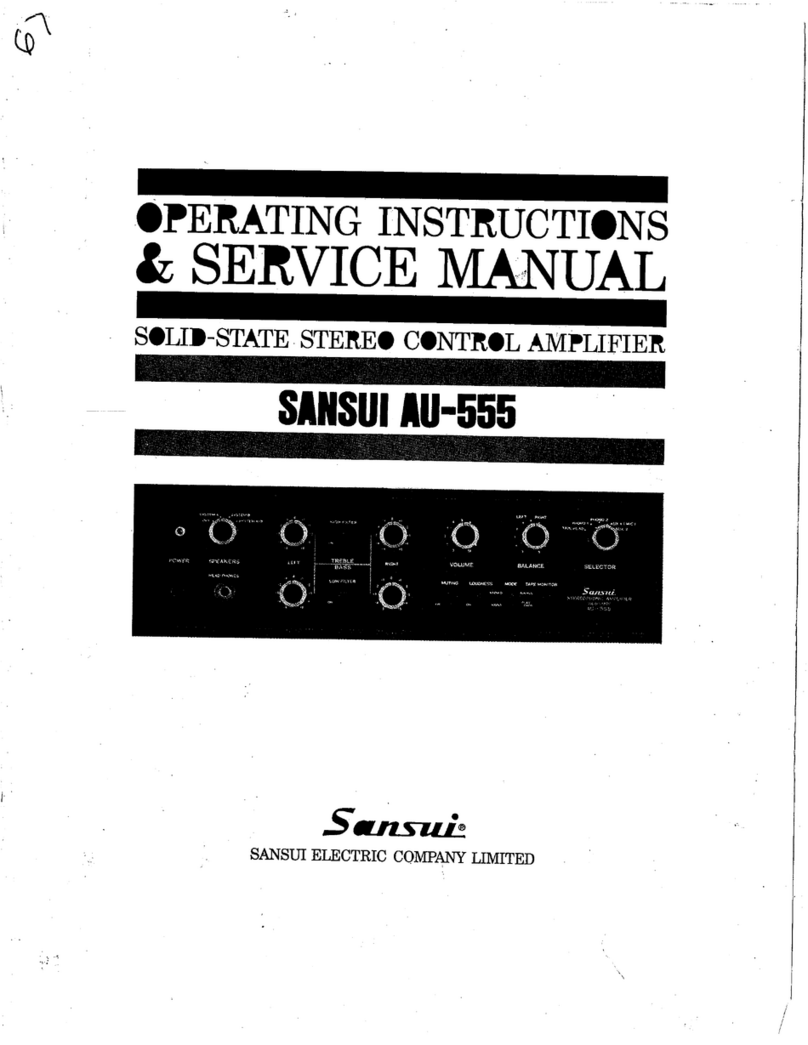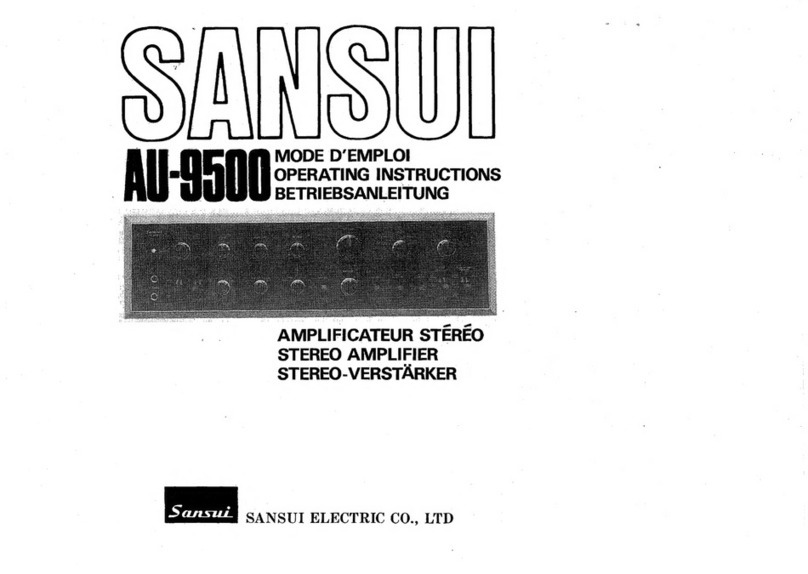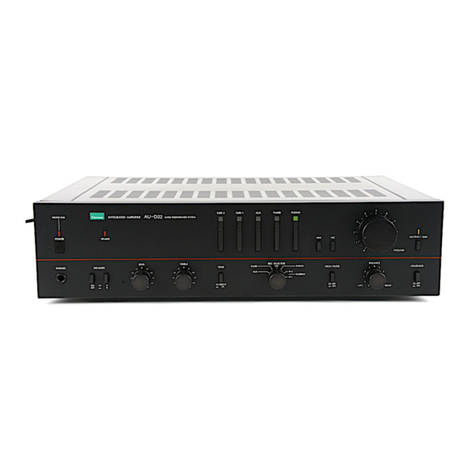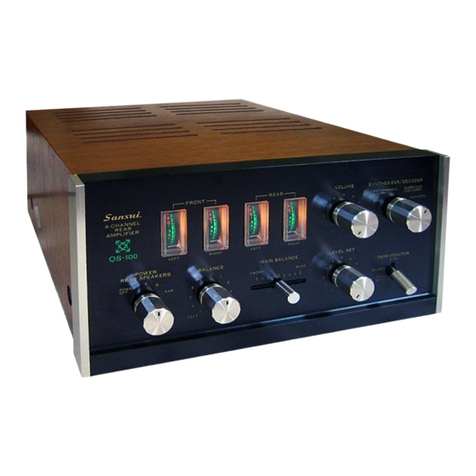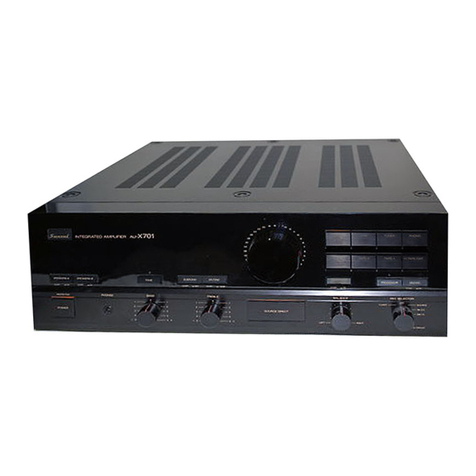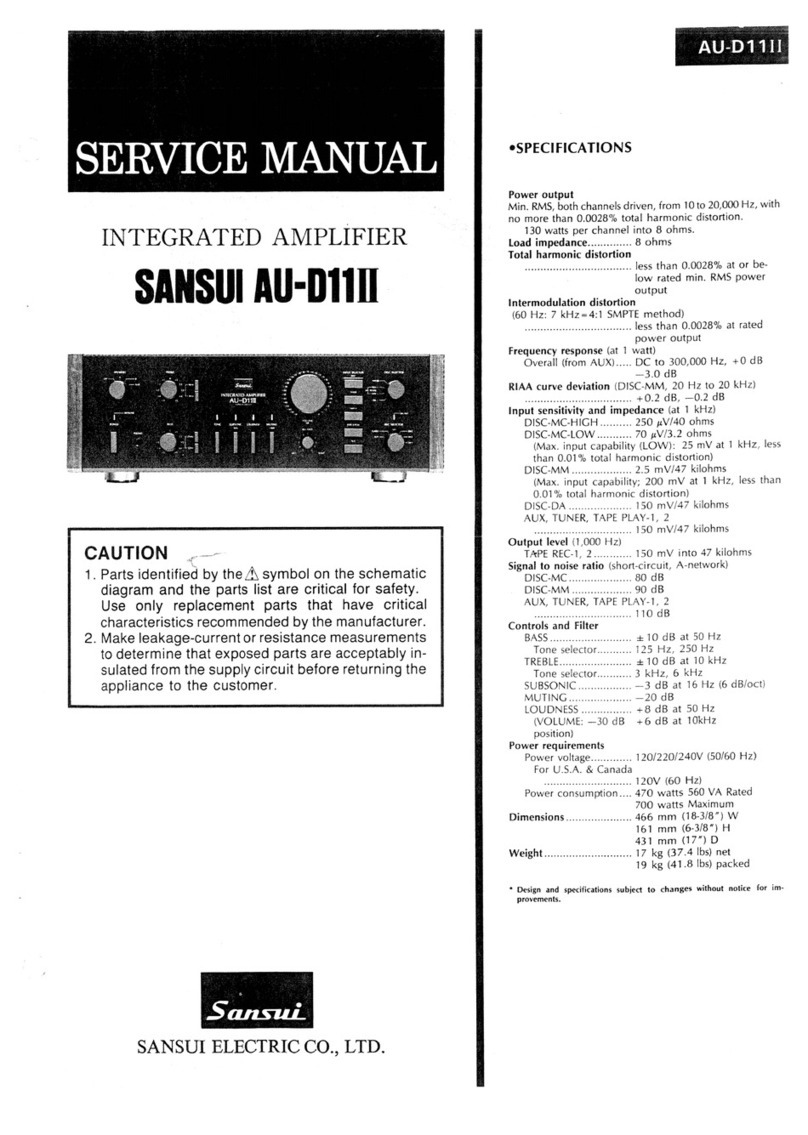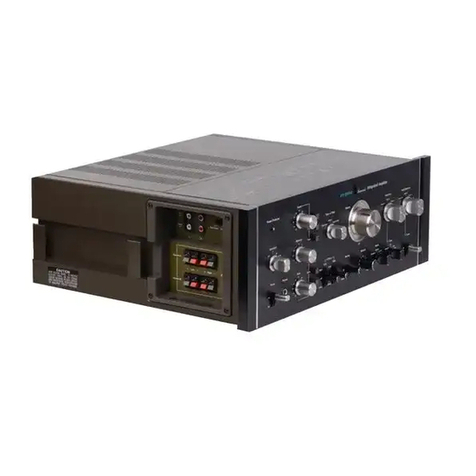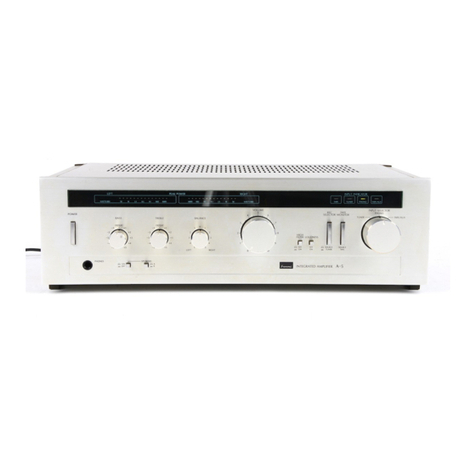
11
CH-2
PANPOT
Control!
|
This
control
is
used
to
position
the
sound
images
reproduced
from
a
guitar
or
microphone
connected
to
the
CH-2
MIC
(GUITAR)
jack,
at
the
desired
location
between
the
left
and
right
speakers.
12
MIXING
BALANCE
Control
This
control
is
for
adjusting
the
volume
balance
when
mixing
the
sound
from
a
microphone
or
guitar
with
a
program
source
selected
by
the
SOURCE
SELECTOR
switch.
The
more
it
is
rotated
to
the
left
the
more
the
microphone
or
guitar
level
is
increased;
conversely,
the
more
it
is
rotated
toward
the
right,
the
more
the
level
of
the
program
source
is
increased.
13
SOURCE
SELECTOR
Switches
These
are
for
selecting
the
program
source.
LINE:
Press
this
switch
when
operating
a
com-
ponent
connected
to
the
amplifier
such
as
a
tuner
or
turntable.
|
TAPE-1:
Press
this
switch
when
playing
back
a
tape
on
a
tape
deck
connected
to
the
unit’s
rear
panel
TAPE-1
terminals.
TAPE-2:
Press
this
switch
when
playing
back
a
tape
on
a
tape
deck
connected
to
the
unit's
rear
panel
TAPE-2
terminals.
14
REVERBERATION
Switches
These
are
used
to
select
the
signals
which
add
the
reverberation
effect.
CH-1:
When
this
switch
is
pressed
to
ON,
a
re-
verberation
effect
is
added
to
the
signals
of
the
microphone
or
guitar
connected
to
the
CH-1
MIC
(GUITAR)
jack.
CH-2:
When
this
switch
is
pressed
to
ON,
a
reverberation
effect
is
added
to
the
signals
of
the
microphone
or
guitar
connected
to
the
CH-2
MIC
(GUITAR)
jack.
SOURCE:
When
this
switch
is
pushed
to
ON,
a
reverberation
effect.
is
added
to
the
input
signals
selected
by
the
SOURCE
SELEC-
TOR
switch.
15
REVERBERATION-REC
Switch
Set
this
switch
to
ON
when
recording
the
signals
which
added
the
reverberation
effect
onto
a
tape
deck
connected
to
the
unit’s
rear
panel
TAPE
terminals.
16
DUBBING
Switches
When
dubbing
(copying)
tapes
using
two
tape
decks
connected
to
the
unit’s
rear
panel,
press
the
“1
»
2”
or
”’2
&®
1”
switch.
It
is
possible
to
listen
to
a
broadcast
or
record
while
dubbing
.
tapes.
OFF:
Keep
this
switch
depressed
when
not
dubbing
tapes.
1
B®
2:
Press
when
dubbing
from
the
TAPE-1
tape
deck
to
the
TAPE-2
tape
deck.
2
be
1:
Press
when
dubbing
from
the
TAPE-2
tape
deck
to
the
TAPE-1
tape
deck.
11
Commande
de
localisation
du
canal
2
(CH-2
PANPOT)
Cette
commande
permet
de
positionner
les
images
sonores
reproduites
a
partir
d‘une
guitare
ou
d’un
microphone
raccordé
4
la
prise
CH-2
MIC
(GUITAR),
sur
l’'emplacement
désiré
entre
les
enceintes
de
droite
et
de
gauche.
12
Commande
d’équilibrage
de
mixage
(MIXING
BALANCE)
Cette
commande
sert
a
équilibrer
le
volume
sonore
lors
du
mixage
du
son
d’‘un
microphone
ou
d’une
guitare
avec
celui
de
la
source
musicale
choisie
au
moyen
du_
sélecteur
de
source
(SOURCE
SELECTOR).
Plus
cette
commande
est
tournée
vers
la
gauche
et
plus
le
niveau
du
microphone
ou
de
la
guitare
est
augmenté;
in-
versément,
plus
elle
est
tournée
vers
la
droite
et
plus
le
niveau
de
fa
source
musicale
est
aug-
menté.
13
Sélecteurs
de
source
(SOURCE
SELECTOR}
lis
sont
prévus
pour
la
sélection
de
la
source
musicale.
.
LINE:
Appuyer
sur
cette
touche
lors
de
I’utili-
sation
d’un
élément
raccordé
a
|’amplificat-
eur,
tel
que
tuner
ou
tourne-disque.
TAPE-1:
Appuyer
sur
cette
touche
lors
de
la
lecture
d‘une
bande
au
moyen
d’un
mag-
nétophone
raccordé
aux
bornes
TAPE-1,
sur
le
panneau
arriére
de
I‘appareil.
TAPE-2:
Appuyer
sur
cette
touche
lors
de
la
lecture
d’une
bande
au
moyen
d‘un
mag-
nétophone
raccordé
aux
bornes
TAPE-2,
sur
le
panneau.
arriére
de
|’‘appareil.
14
Commutateurs
de
réverbération
(REVERBERATION)
Ces
touches
sont
utilisées
pour
la
sélection
des
signaux
ajoutant
l’effet
de
réverbération.
CH-1:
Lorsque
cette
touche
est
enfoncée
sur
ON,
un
effet
de
réverbération
est
ajouté
aux
signaux
du
microphone
ou
de
la
guitare
raccordé
a
la
prise
CH-1
MIC
(GUITAR).
CH-2:
Lorsque
cette
touche
est
enfoncée
sur
ON,
un
effet
de
réverbération
est
ajouté
aux
signaux
du
microphone
ou
de
la
guitare
raccordé
a4
la
prise
CH-2
MIC
(GUITAR).
SOURCE:
Lorsque
cette
touche
est
enfoncée
sur
ON,
un
effet
de
réverbération
est
ajouté
aux
signaux
d‘entrée
sélectionnés
au
moyen
du
sélecteur
de
source
(SOURCE
SELEC-
TOR).
15
Commutateur
de
réverbération
a
l’en-
registrement
(REVERBERATION-REC)
Régler
cette
touche
sur
la
position
enclenché
(ON)
lors
de
l’enregistrement
de
signaux
avec
effet
de
réverbération
au
moyen
du
magnéto-
phone
raccordé
aux
bornes
TAPE
du
panneau
arriére
de
l'appareil.
16
Commutateurs
de
copie
(DUBBING)
Lors
de
la
copie
de
bandes
au
moyen
de
deux
magnétophones
raccordés
au
panneau
arriére
de
‘appareil,
appuyer
sur
la
touche
“7
®
2”
ou
"2
»
1°.
Il
est
possible
d’écouter
une
émission
ou
un
disque
pendant
la
copie
de
bandes.
OFF:
Cette
touche
doit
&tre
conservée
en-
foncée
lorsqu’aucune
copie
de
bande
n’est
réalisée.
1
p&
2:
Enfoncer
cette
touche
pour
copier
du
magnétophone
TAPE-1
au
magnétophone
TAPE-2.
2
be
1:
Enfoncer
cette
touche
pour
copier
du
magnétophone
TAPE-2
au
magnétophone
TAPE-1.
einem
der
11
Panpotregler
fiir
Kanal
2
(CH-2
PANPOT)
,
Mit
Hilfe
dieses
Reglers
kann
das
Klangbild,
das
von
einer
Gitarre
oder
einem
Mikrofon
erzeugt
wird,
wunschgema&
zwischen
linkem
und
rechtem
Lautsprecher
positioniert
werden,
wenn
diese
an
die
Buchse
“’CH-2
MIC
(GUITAR)"
angeschlossen
sind.
12
Misch-Balanceregler
(MIXING
BALANCE)
Beim
Mischen
des
Mikrofon-
oder
Gitarrenton
mit
dem
Ton
einer
Programmauelle,
die
mit
Programmauellen-Wah|schalter
gewahlt
wurde,
la&t
sich
die
Lautstark
ebalance
mit
diesem
Regler
wunschgemafs
justieren.
Der
Lautstarkepegel
von
Mikrofon
oder
Gitarre
wird
bei
zunehmendem
Drehen
des
Reglers
nach
links
erhoht;
umgekehrt
nimmt
der
Laut-
starkepegel
der
Programmauelle
zu,
je
weiter
dieser
Regler
nach
rechts
gedreht
wird.
13
Programmaquellen-Wahlschalter
(SOURCE
SELECTOR)
Diese
Schalter
dienen
zur
Wahl
der
Programm-
quelle.
LINE:
Drucken
Sie
diesen
Schalter,
wenn
Sie
eine
an
den
Verstarker
angeschlossene
Kom-
ponente,
z.B.
einen
Tuner
oder
einen
Plattenspieler,
verwenden.
TAPE-1:
Orticken
Sie
diesen
Schalter,
um
ein
Band
mit
einem
an
die
“’T
APE-1‘’-Anschlu-
buchsen
auf der
Gerateruckseite
ange-
schiossenen
Bandgerat
wiederzugeben.
TAPE-2:
Driicken
Sie
diesen
Schalter,
um
ein
Band
mit
einem
an
die
‘“TAPE-2"-AnschluB-
buchsen
auf
der
Geratertickseite
angesch-
lossenen
Bandgerat
wiederzugeben.
14
Hallschalter
(REVERBERATION)
Diese
Schalter
dienen
zur
Wahi
der
Signale,
die
den
Halleffekt
hinzufugen.
CH-1:
Bei
Driicken
dieses
Schalters
auf
Stellung
“ON
{Ein)
wird
den
Signaten
eines
Mikro-
fons
oder
einer
Gitarre
ein
Halleffekt
hin-
zugefiigt,
wenn
diese
an
die
Buchse
‘’CH-1
MIC
(GUITAR)
angeschlossen
sind.
CH-2:
Bej
Driicken
dieses
Schalters
auf
Stellung
“ON”
(Ein)
wird
den
Signalen
eines
Mikro-
fons
oder
einer
Gitarre
ein
Halleffekt
hin-
zugeflgt,
wenn
diese
an
die
Buchse
"CH-2
MIC
{GUITAR}
angeschlossen
sind.
SOURCE:
Bei
Driicken
dieses
Schalters
auf
Stellung
“ON”
(Ein)
wird
den
mit
Hilfe
des
Programmauellen-Wahischaiters
gewahlten
Eingangssignalen
ein
Halleffekt
hinzugefugt.
15
Hallaufnahme-Schalter
(REVERBERATION-REC)
Stellen
Sie
diesen
Schalter
auf
“ON”,
um
Sig-
nale,
die
einen
Halleffekt
hinzufigen,
auf
einem
an
die
“TAPE”-Anschlu&buchsen
auf
der
Gerdtertickseite
angeschlossenen
Bandgerat
auf-
zunehmen.
16
Uberspielschalter
(DUBBING)
Drucken
Sie
die
Schalter
‘1
®
2”
oder
"2
®
1",
wenn
Sie
Bander
mit
zwei
an
die
Gerdteruck-
seite
angeschlossenen
Bandgeraten
Uuberspielen
(kopieren}.
Eine
Rundfunksendung
oder
eine
Schaliplatte
kann
w&hrend
des
Uberspielens
von
Bandern
gehort
werden.
OFF:
Stelfen
Sie
diesen
Schalter
auf
die
ge-
|
driickte
Stellung,
wenn
Sie
keine
Bander
uberspieten.
1
bP
2:
Driicken
Sie
diesen
Schalter,
wenn
Sie
von
Bandgerat
1
(TAPE-1)
auf
Bandgerat
2
(TAPE-2)
tberspielen.
2
1:
Driicken
Sie
diesen
Schalter,
wenn
Sie
von
Bandgerat
2
(TAPE-2)
Bandgeraét
1
{TAPE-1)
iberspielen.
